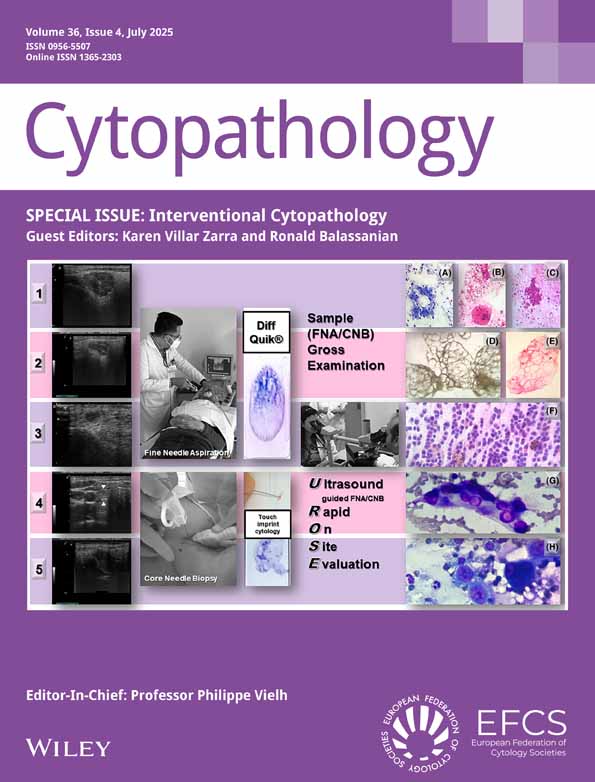Human papillomavirus (HPV) in high-grade cervical intraepithelial neoplasia (CIN) detected by morphology and polymerase chain reaction (PCR)—a cytohistologic correlation of 277 cases treated by laser conization
Human papillomavirus (HPV) in high-grade cervical intraepithelial neoplasia (CIN) detected by morphology and polymerase chain reaction (PCR)—a cytohistologic correlation of 277 cases treated by laser conization
enThe aims of this study were to evaluate the cytohistologic correlation in women treated for high-grade lesions of the cervix uteri (HG CIN), to assess the distribution of HPV features and finally to test the validity of the morphological criteria of HPV infection. The smears and biopsy specimens from 277 women treated for HG CIN by laser conization were re-evaluated blindly. Tissue blocks (n= 188) and 52 archival smears were examined for HPV DNA using PCR. HPV changes were detected with equal frequency in the smears and biopsy specimens by light microscopy; 63% and 65%, respectively. The prevalence of HPV DNA in biopsies was 88% and in archival smears 85%; agreement was found in 89% of the cases. Using PCR as the gold standard, we found a sensitivity of 63% for cytology and 70% for histology; the specificity was 41% and 37%, respectively. The positive predictive value was > 80%, but the negative predictive value was < 20%. Our study confirms that HPV features are frequently associated with HG CIN and that morphology is a non-specific method of identifying HPV infection and should be followed by PCR, also allowing detection of oncogenic HPV types and latent infections.
Présence de virus Papillome Humain dans les lésions cervicales intraépithéliales de haut grade détectée par la morphologie et par la PCR. Corrélation cyto-histologique sur 227 cas traités par conisation au laser.
frCette étude a été faite dans le but d'évaluer la corrélation cyto-histologique chez les patientes traitées pour une lésion cervicale de haut grade (CIN HG), afin d'établir la distribution des signes d'infection par le VPH et de tester la validité des critères morphologiques de l'infection par le VPH. Les frottis et les biopsies de 227 patientes ayant été traitées pour une CIN de haut grade par conisation au laser ont été revus, sans renseignement. L'ADN viral a été recherché par la méthode de PCR sur 188 blocs et 52 frottis d'archives.
La présence de signes morphologiques d'infection par le VPH a été observée avec la même fréquence sur les frottis et sur les biopsies, 63% et 65% respectivement. La prévalence de la présence d'ADN viral est de 88% dans les biopsies et de 85% dans les frottis d'archives; il y a concordance dans 89% des cas. En prenant la PCR comme technique de référence, nous trouvons une sensibilité de 63% pour la cytologie et de 70% pour l'histologie, la spécificitéétant respectivement de 41% et de 37%. La valeur prédictive positive est supérieure à 80%, mais la valeur prédictive négative est inférieure à 20%. Notre étude apporte la confirmation que des signes morphologiques d'infection par le VPH sont fréquemment associés aux CIN de haut grade, que la morphologie est une méthode d'identification de l'infection par le VPH non spécifique et qu'elle pourrait être complétée par la PCR, ce qui permettrait de détecter les types de VPH oncogènes et les infections latentes.
Nachweis humaner Papillomaviren in schweren zcrvikalen intraepithelialen Neoplasien durch Morphologie und PCR. Korrelation zwischen Zytologie und Histologie in 277 Fällen mit Laserkonisation.
deZiel der Studie war es die Korrelation zwischen Zytologie und Histologie sowie den Wert der morphologischen HPV–Kriterien zu ermitteln. Die erneute Auswertung der 277 Fälle erfolgte blind. 188 histologische Blöcke und 52 archivierte Abstriche wurden nach der Laserkonisation mit der PCR auf HPV hin untersucht.
HPV–Veränderungen wurden morphologisch in beiden Materialien gleich häufig nachgewiesen: Abstriche 63%, Biospie 65%. HPV–DNA fand sich in 88% der Biopsien und 85% der Abstriche. Übereinstimmung bestand in 89% der Fälle. Bezogen auf PCR betrug die Sensitivität der Zytologie 63% und 70% für die Histologie. Die Spezifität betrug jeweils 41% bzw. 37%. Der positive prädiktive Wert lag über 80%, der negative jedoch unter 20%. Die Studie bestätigt, dass HPV–Veränderungen bei in traepithelialen Neoplasien häufig sind, die Morphologie jedoch unspezifisch ist und durch die PCR bestätigt werden sollte. Auf diese Weise können auch onkogene HPV–Subtypen nachgewiesen werden.




